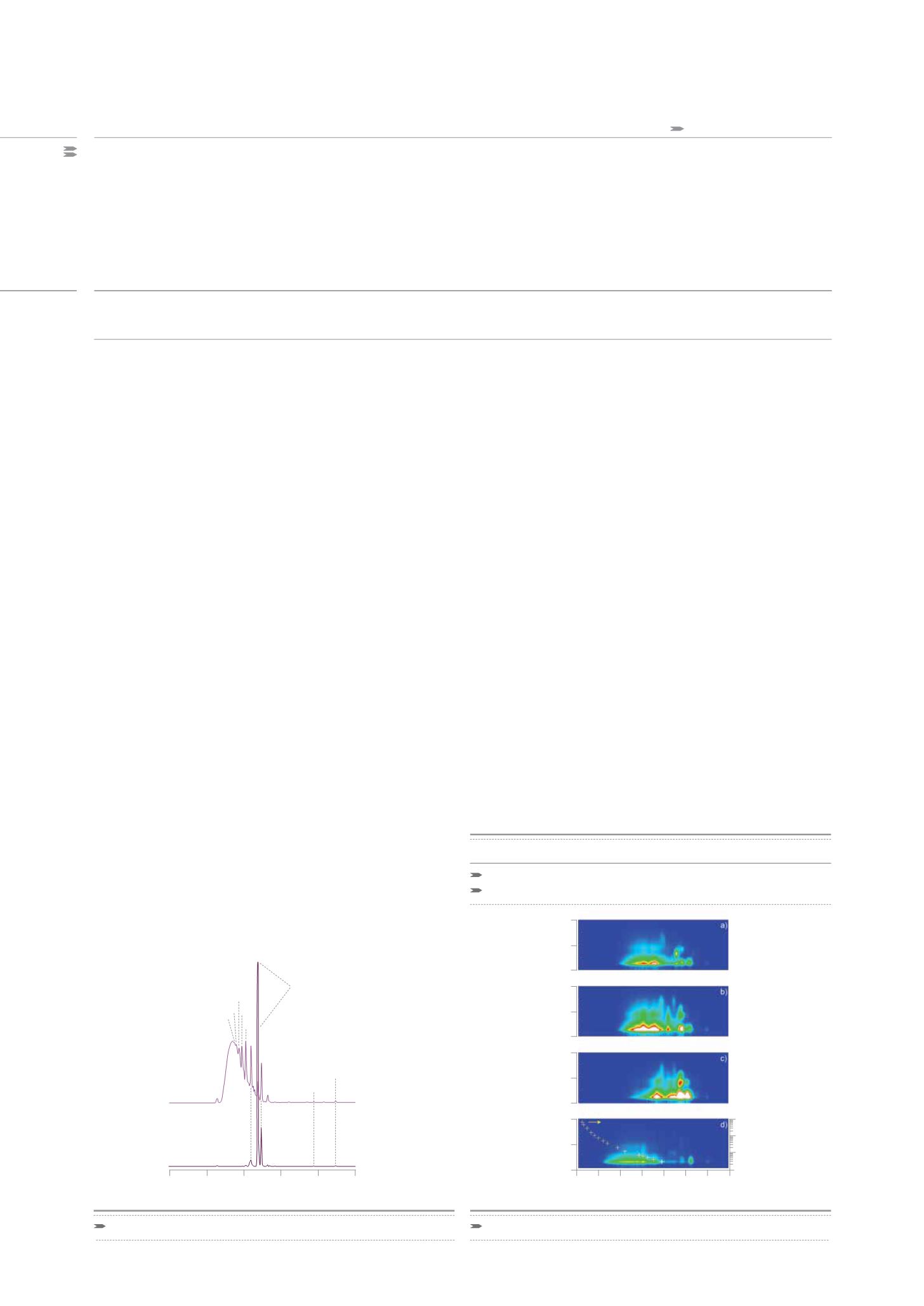
retention time [min]
mw [da]
wavelength [nm]
200
200
200
200
17.5 20.0 22.5 25.0 27.5 30.0 32.5
10
5
10
4
10
3
10
2
400
400
400
400
300
300
300
300
15.0
Due to the expected depletion of fossil fuels, alternatives are required
for the supply of our societies with fuels and alternative feedstocks for
chemical production. Different types of biomass are suitable for this,
but lignocellulose is the preferred option, since there is no competition
with food and feed. The work in the group of Dr. Rinaldi is focussed on
the depolymerizationof cellulose and further conversionof the resulting
sugars. The depolymerization of cellulose, our largest reserve of
green carbon, is the critical step in the production of biofuels and
chemicals from lignocellulose. Dr. Rinaldi and colleagues showed that
the impregnation of cellulosic substrates with catalytic amounts of
strong acid is a highly effective strategy to fully convert cellulose in a
solvent free process into water-soluble oligosaccharides
1
.
Mass spectrometry and size exclusion chromatography were used to
characterize the soluble oligosaccharides andmonitor their conversion
into glucose and xylose in a subsequent acid hydrolysis step. ESI-MS
spectra showed that the depolymerization process was effective for
the conversion of
α
-cellulose to a complex mixture of water-soluble
oligosaccharides containing glucose, xylose, and levoglucosan units,
mostly comprising 3-6 sugar units. The oligosaccharides were further
hydrolyzed at 130°C, resulting in 91% conversion of glucans into
glucose and 96% of xylans into xylose. The figure below shows the
water soluble oligomers obtained by depolymerization of cellulose
(A) and the sample after 1 hour of acid hydrolysis (B). The numbers
(n) indicate the degree of polymerization of oligosaccharides (Glcn).
The separation was performed at 80°C with a set of four TSKgel
G-Oligo-PW columns (6 µm, 7.8 mm ID x 30 cm) in series.
Besides TSKgel PW series columns used for the analysis of
watersoluble oligomers, Dr. Rinaldi also successfully applied
TSKgel SuperHZ series semi micro GPC columns for samples
dissolved in organics, e.g. when analyzing the solvent effects on
the hydrogenolysis of lignin with Raney Nickel
2
. The figure below
depicts the GPC analysis (2x TSKgel Super HZ1000, 1x SuperHZ2000,
1x TSKgel SuperHZ3000 in series at 60°C with THF as mobile phase,
photodiode array detection) of thermally treated lignin in a) methanol,
b) 2-propanol, c) methylcyclohexane (MCH), and of d) organosolv lignin.
The UV-absorption spots at around 275 nm indicate the presence
of phenolic species in the solution, produced by heating a suspension
of lignin in various solvents up to 300 °C. The higher retention time of
the products obtained in MCH shows that smaller phenolic fragments
are formed in the aprotic nonpolar solvent MCH than in 2-propanol or
methanol. The results demonstrate that the solvent plays a key role in
directing the selectivity of the thermolysis of lignin.
We are glad to see that our TSKgel SEC columns are applied in such
a broad range of applications which may further contribute to the
expanded use of cellulose based renewable resources in the production
of biofuels and platform chemicals.
REFERENCES
1
|
N. Meine, R. Rinaldi, & F. Schüth, ChemSUSChem 2012, 5, 1449-1454
2
|
X Wang & R. Rinaldi , ChemSUSChem 2012, 5, 1455-1466
Tosoh
customer magazine
SEC/GPC Analysis in Biomass Research
The ‘Max-Planck-Institut für Kohlenforschung’ in Mülheim, Germany – famous for the work on polyethylene
synthesis by Karl Ziegler resulting in several patents and the Noble Prize for Chemistry in 1963 – pursues basic
research in all fields of catalysis. The central theme pervading all departments is basic research in the catalytic
transformation of compounds and materials with the highest degree of chemo-, regio- and stereoselectivity
under conditions which maximize efficient use of natural resources. Dr. Roberto Rinaldi and colleagues (Group
Heterogeneous Catalysis, Prof. Dr. Ferdi Schüth) are working on biomass conversion. We had the chance to meet
Dr. Rinaldi in his lab to talk about the application of TSKgel SEC/GPC columns in this fascinating research area.
06
SEC/GPC
News from the field
Acid Hydrolysis of Oligosaccharides
GPC Analysis of Thermally Treated Lignin
retention time [min]
20
0
40
60
80
100
glucose
xylose
5-HMF
furfural
x10
7
6
5
4
3
2
a
b


